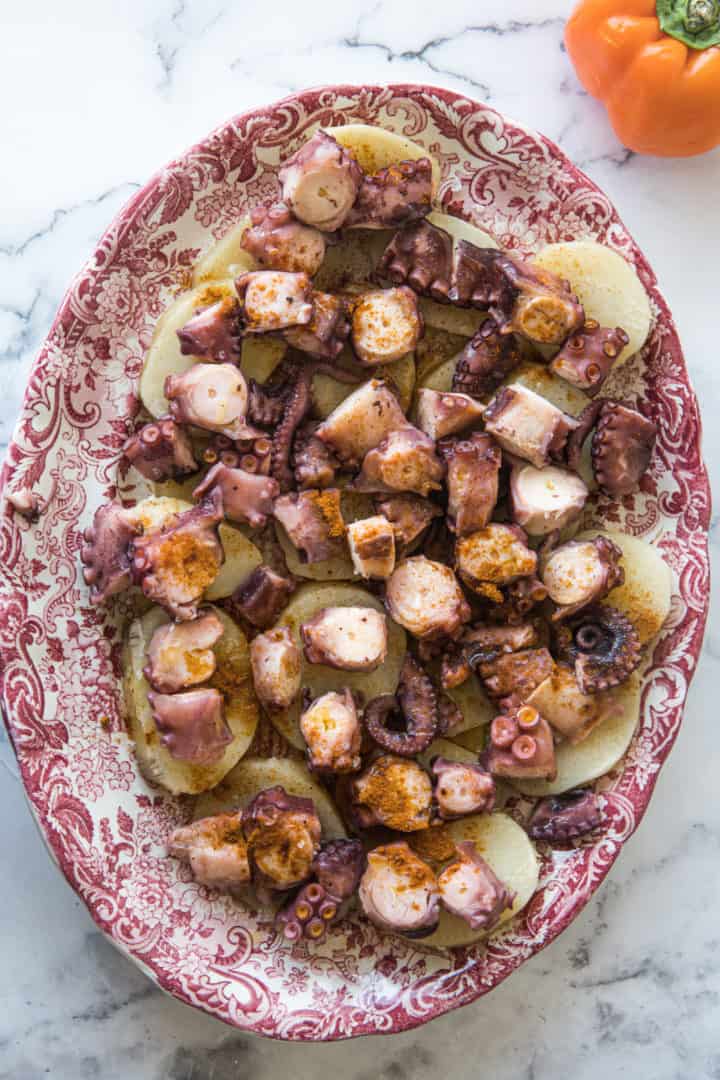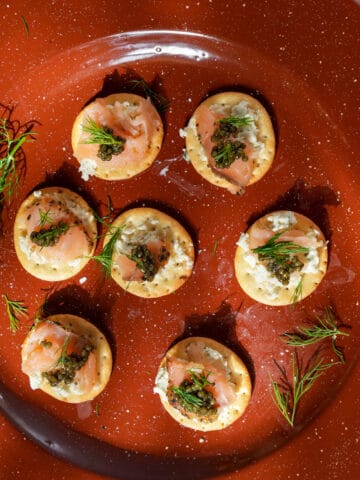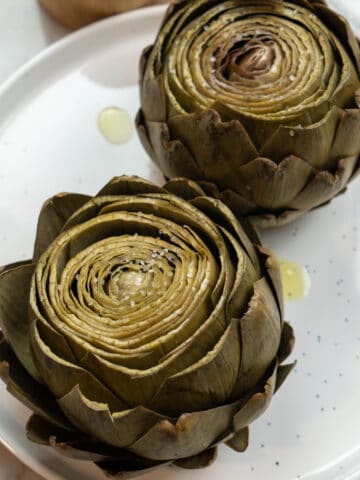This Spanish Octopus Recipe (Pulpo a la Gallega) is made with boiled potatoes, cooked octopus, olive oil, pimentón, and salt and arranged on a large platter.

This recipe is the easiest way to make Pulpo a la Gallega. I made this recipe by using already cooked octopus that I purchased at Costco. Most fish markets sell cooked octopus or can prepare it for you before buying. If all else fails, cooking a whole octopus is actually very easy. For a 1 to 2 pound octopus, it takes about an hour to cook in boiling water. You know the octopus is ready when you are easily able to insert a paring knife to where the legs and the head meet.
If you love this recipe, feel free to try my Spanish Garlic Shrimp or my Pan Tumaca.
Jump to:
- What is Spanish Octopus?
- Why you will love this Galician Octopus
- Pulpo a la Gallega Ingredients
- How to make this Spanish Octopus Recipe
- What to serve with Spanish Octopus
- Substitutions
- Spanish Octopus Recipe Variations
- Equipment
- How to store Spanish Octopus
- Spanish Octopus Recipe Top tips
- Spanish Octopus Recipe
- Food safety
What is Spanish Octopus?
Spanish Octopus, also known as pulpo a la gallega, is a popular Spanish dish that features tender, flavorful octopus that is typically served on a bed of sliced potatoes and drizzled with olive oil and sprinkled with smoked paprika. It is a staple dish in the Galicia region of Spain, where it is often served as a tapa or appetizer. Spanish Octopus is typically prepared by boiling the octopus in a large pot with onions, bay leaves, and salt until it is tender, and then slicing it into small pieces before serving. It is a dish that is beloved for its unique texture and flavor, and is often enjoyed with a glass of crisp white wine.
Why you will love this Galician Octopus
Versatile: Feel free to add more or less olive oil and paprika. You could add any other spices on top as well.
Great for warm weather: I lived in Madrid for four years, and I would eat this at bars with a nice glass fo Rioja.
Pulpo a la Gallega Ingredients
You'll only need a few simple ingredients to make this. The exact measurements are listed in the recipe card below. Here's an overview of what you'll need:
- Gold Potatoes
- Cooked octopus (See substitutions for uncooked octopus)
- Extra-virgin olive oil
- Pimentón (Smoked paprika)
See recipe card for quantities of this Spanish Octopus Recipe (Pulpo a la Gallega).
How to make this Spanish Octopus Recipe

Start by taking the skin off the potatoes with a vegetable peeler and place them in a pot of boiling water or a steamer if you have one. Keeping boiling on high heat until potatoes are easily pierced with a paring knife, about 20 minutes. Take the potatoes out but do not pour out the water.

Turn the heat off and drop the cooked octopus into the water. We aren’t trying to cook the octopus, rather warm it up in the same water. (See note below if your octopus is uncooked).

Rinse the potatoes under cold water until cool, then slice. Arrange the sliced potatoes on a serving platter, spread out. Drain the octopus and slice the tentacles into bite size pieces.

Place the octopus on the slices of potatoes and drizzle olive oil over it. Sprinkle salt and pimentón on the octopus and potatoes.
Note: For a 1 to 2 pound octopus, it takes about an hour to cook in boiling water. You know the octopus is ready when you are easily able to insert a paring knife to where the legs and the head meet.
What to serve with Spanish Octopus
- Potatoes: Spanish octopus is often served with potatoes, either boiled or roasted. The potatoes can be seasoned with herbs, garlic, or paprika to complement the flavor of the octopus.
- Grilled Vegetables: Grilled vegetables such as bell peppers, onions, and zucchini can add a smoky flavor to the dish and provide a healthy complement to the protein.
- Rice: Spanish-style rice, such as paella or arroz con pollo, is a popular accompaniment to octopus in Spain.
- Salad: A light salad with a citrus dressing can add a refreshing contrast to the rich flavor of the octopus.
- Bread: A crusty loaf of bread is a great way to soak up the flavorful sauce that accompanies the octopus.
- Wine: Pair the dish with a dry white wine, such as Albariño or Verdejo, or a light-bodied red wine, such as Tempranillo or Garnacha.
Substitutions
Octopus: Most supermarkets sell cooked octopus tentacles instead of whole uncooked octopus. You will only need to warm it up in the boiling water for a minute or two.
Potatoes: Traditionally, this uses gold potatoes, but feel free to use russet, Yukon or even baby potatoes.
Olive oil: It is important to use good quality extra-virgin olive oil for this. You could use good quality avocado oil as well.
Pimentón: I love using pimentón, or smoked paprika. You can opt to using regular paprika as well.
Spanish Octopus Recipe Variations
- Grilled Spanish Octopus: Clean and tenderize the octopus, then grill it until charred on the outside and tender on the inside. Serve with lemon wedges and a drizzle of olive oil.
- Spanish Octopus Salad: Slice cooked octopus into bite-sized pieces and mix with cooked potatoes, green beans, red onion, and a sherry vinaigrette. Chill the salad and serve it as a refreshing appetizer or main course.
- Spanish Octopus Stew: Cook octopus with sofrito (a mix of onions, peppers, and tomatoes), white wine, and broth until tender. Add chickpeas and chorizo for an extra flavor boost and serve with crusty bread.
- Spanish Octopus Ceviche: Cut cooked octopus into small pieces and mix with lime juice, chopped onions, jalapenos, and cilantro. Allow the mixture to marinate in the fridge for a few hours before serving with tortilla chips.
- Spanish Octopus with Potatoes: Boil potatoes until tender, then slice and fry them until crispy. Serve the potatoes with slices of grilled octopus, seasoned with smoked paprika and olive oil.
Check out this Spanish Tortilla for more delicious tapas.

Equipment
- Large pot or Dutch oven: To cook the octopus, you will need a pot or Dutch oven large enough to submerge the octopus completely in water.
- Tongs: Tongs will help you to safely remove the octopus from the pot of boiling water.
- Cutting board and knife: You will need a cutting board and a sharp knife to cut the octopus into smaller pieces.
- Large bowl: You will need a large bowl to toss the grilled octopus with the dressing and other ingredients.
- Whisk: To make the dressing, you will need a whisk to combine the ingredients thoroughly.
- Measuring cups and spoons: You will need measuring cups and spoons to measure the ingredients for the dressing.
How to store Spanish Octopus
To store Spanish octopus, let it cool to room temperature and transfer it to an airtight container. It can be stored in the refrigerator for up to 3 days. If you're planning to keep it longer, you can freeze it for up to 2 months. Wrap the octopus tightly in plastic wrap and then place it in a freezer-safe bag or container before storing it in the freezer. When you're ready to eat, thaw the octopus overnight in the refrigerator before reheating and serving.
Spanish Octopus Recipe Top tips
- Tenderize the octopus: Octopus can be tough, so it's important to tenderize it before cooking. This can be done by freezing it before cooking or by simmering it in a flavorful broth for an extended period of time.
- Use quality ingredients: Because Spanish Octopus is a simple dish, it's important to use high-quality ingredients. This includes fresh octopus, extra virgin olive oil, sea salt, and smoked paprika.
- Add flavor with aromatics: While garlic and onion are the most common aromatics used in Spanish Octopus, you can also experiment with adding other flavors such as fresh herbs, lemon, or orange.
- Keep it simple: Spanish Octopus is a dish that is meant to highlight the flavor of the octopus itself, so it's best to keep the preparation simple. Avoid adding too many ingredients or flavors that will overpower the octopus.
- Don't overcook: Octopus can become rubbery if overcooked, so it's important to watch it carefully and remove it from the heat as soon as it is tender.
- Let it rest: After cooking, it's important to let the Spanish Octopus rest for a few minutes before slicing and serving. This allows the juices to redistribute, resulting in a more flavorful and tender dish.

Spanish Octopus Recipe
- Total Time: 40 minutes
- Yield: 4 servings 1x
Description
This Spanish Octopus Recipe (Pulpo a la Gallega) is made with boiled potatoes, cooked octopus, olive oil, pimentón, and salt and arranged on a large platter.
Ingredients
- 2-3 large gold potatoes, peeled
- 6 cooked octopus tentacles
- 1 tablespoon olive oil
- 1 tablespoon pimentón or paprika
- Salt
Instructions
- Start by taking the skin off the potatoes with a vegetable peeler and place them in a pot of boiling water or a steamer if you have one.
- Keeping boiling on high heat until potatoes are easily pierced with a paring knife, about 20 minutes.
- Take the potatoes out but do not pour out the water.
- Turn the heat off and drop the cooked octopus into the water. We aren’t trying to cook the octopus, rather warm it up in the same water. (See note below if your octopus is uncooked).
- Rinse the potatoes under cold water until cool, then slice.
- Arrange the sliced potatoes on a serving platter, spread out. Drain the octopus and slice the tentacles into bite size pieces. Place the octopus on the slices of potatoes and drizzle olive oil over it. Sprinkle salt and pimentón on the octopus and potatoes.
Notes
- Tenderize the octopus: Octopus can be tough, so it's important to tenderize it before cooking. This can be done by freezing it before cooking or by simmering it in a flavorful broth for an extended period of time.
- Use quality ingredients: Because Spanish Octopus is a simple dish, it's important to use high-quality ingredients. This includes fresh octopus, extra virgin olive oil, sea salt, and smoked paprika.
- Add flavor with aromatics: While garlic and onion are the most common aromatics used in Spanish Octopus, you can also experiment with adding other flavors such as fresh herbs, lemon, or orange.
- Keep it simple: Spanish Octopus is a dish that is meant to highlight the flavor of the octopus itself, so it's best to keep the preparation simple. Avoid adding too many ingredients or flavors that will overpower the octopus.
- Don't overcook: Octopus can become rubbery if overcooked, so it's important to watch it carefully and remove it from the heat as soon as it is tender.
- Let it rest: After cooking, it's important to let the Spanish Octopus rest for a few minutes before slicing and serving. This allows the juices to redistribute, resulting in a more flavorful and tender dish.
- Prep Time: 10 minutes
- Cook Time: 30 minutes
- Category: Dinner
- Method: Boiling
- Cuisine: Spanish
Nutrition
- Serving Size: 1
- Calories: 153
- Fat: 3.2g
- Saturated Fat: 0.6g
- Carbohydrates: 9.8 g
- Fiber: 0.8g
- Protein: 20g
- Cholesterol: 63mg
Food safety
- Cook to a minimum temperature of 165 °F (74 °C)
- Do not use the same utensils on cooked food, that previously touched raw meat
- Wash hands after touching raw meat
- Don't leave food sitting out at room temperature for extended periods
- Never leave cooking food unattended
- Use oils with high smoking point to avoid harmful compounds
- Always have good ventilation when using a gas stove








Leave a Reply